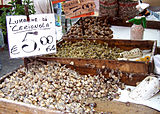Octopus
| Octopus Temporal range: Late Carboniferous – Recent
| |
|---|---|
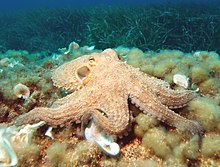
| |
| Common octopus (Octopus vulgaris) | |
| Scientific classification | |
| Domain: | Eukaryota |
| Kingdom: | Animalia |
| Phylum: | Mollusca |
| Class: | Cephalopoda |
| (unranked): | Neocoleoidea |
| Clade: | Vampyropoda |
| Superorder: | Octopodiformes |
| Order: | Octopoda Leach, 1818[1] |
| Suborders | |
| Synonyms | |
| |
The octopus (/ˈɒktəpʊs/ or /ˈɒktəpəs/) is a cephalopod mollusc of the order Octopoda. It has two eyes and four pairs of arms and, like other cephalopods, it is bilaterally symmetric. It has a beak, with its mouth at the centre point of the arms. The body is made of soft material with no internal or external skeleton and can alter its shape, appearance and colour with great rapidity, enabling the octopus to squeeze through small gaps. The mantle cavity is used both for respiration and for locomotion, by expelling a jet of water. Octopuses have a complex nervous system and excellent sight, and are among the most intelligent and behaviourally diverse of all invertebrates.
Octopuses inhabit diverse regions of the ocean, including coral reefs, pelagic waters, and the seabed; some occur in the intertidal zone and others at abyssal depths. Most species grow fast, mature early and are short-lived. During breeding, the male uses a specially adapted arm to deliver a bundle of sperm direct into the female's mantle cavity, after which he goes into a decline. The female deposits fertilised eggs in a den and cares for them until they hatch, after which she also dies.
Octopuses have numerous strategies for defending themselves against predators, including the expulsion of ink, the use of camouflage and deimatic displays, their ability to jet quickly through the water, and their ability to hide. They trail their eight arms behind them as they swim. All octopuses are venomous, but only one group, the blue-ringed octopuses, is known to be deadly to humans. Around 300 species are recognised.
Octopuses appear in mythology as sea monsters like the Kraken of Norway and the Akkorokamui of the Ainu, and probably the Gorgon of ancient Greece. A battle with an octopus appears in Victor Hugo's book Toilers of the Sea, inspiring other works such as Ian Fleming's Octopussy. Octopuses appear in Japanese erotic art, shunga. They are eaten in many parts of the world, especially the Mediterranean and the Asian seas.
Etymology and pluralization
The scientific Latin term octopus was derived from Ancient Greek ὀκτώπους (oktōpous, "eight-footed"), a compound form of ὀκτώ (oktō, "eight") and πούς (pous, "foot").[3][4][5] Related to the word "octopus" are the terms "Octopoda" (the taxonomic order of cephalopod molluscs that comprises the octopuses) and the adjectival octopoid (with the suffix -oid, which signifies a resemblance to, but distinction from, something).[6]
The standard pluralised form of "octopus" in the English language is "octopuses" /ˈɒktəpʊsɪz/,[7] although the Ancient Greek plural "octopodes" /ɒkˈtɒpədiːz/ ahk-TOP-oh-dees, has also been used historically.[6] The alternative plural "octopi" – which misguidedly assumes it is a Latin "-us"-word – is considered grammatically incorrect.[8][9][10][11] It is nevertheless used frequently enough to make it notable, and was formally acknowledged by the descriptivist Merriam-Webster 11th Collegiate Dictionary and Webster's New World College Dictionary. The Oxford English Dictionary (2008 Draft Revision)[12] lists "octopuses", "octopi", and "octopodes", in that order, labeling "octopodes" as rare and noting that "octopi" is based on a misunderstanding.[13] In contrast, New Oxford American Dictionary (3rd Edition 2010) lists "octopuses" as the only acceptable pluralization, with a usage note indicating that "octopodes" is still occasionally used, but "octopi" is incorrect.[14]
Anatomy and physiology
Size

The giant Pacific octopus (Enteroctopus dofleini) is often cited as the largest known octopus species. Adults usually weigh around 15 kg (33 lb), with an arm span of up to 4.3 m (14 ft).[15] The largest specimen of this species to be scientifically documented was an animal with a live mass of 71 kg (156.5 lb).[16] The alternative contender is the seven-arm octopus, Haliphron atlanticus, based on a 61 kg (134 lb) carcass estimated to have a live mass of 75 kg (165 lb).[17][18] However, a number of questionable size records would suggest the giant Pacific octopus is the largest of all known octopus species by a considerable margin;[19] one such record is of a specimen weighing 272 kg (600 lb) and having an arm span of 9 m (30 ft).[20] The smallest species is Octopus wolfi, which is only around 2.5 cm (1 in) and weighs less than 1 g (0.035 oz).[21]
External characteristics
Like all cephalopods, the octopus is bilaterally symmetrical along its dorso-ventral axis; the head and foot are at one end of an elongated body and function as the anterior (front) of the animal. The head includes the mouth, radula and brain. The foot has evolved into a set of flexible, prehensile appendages, known as arms, that surround the mouth and are attached to each other near their base by a webbed structure.[22] The bulbous and hollow mantle is fused to the back of the head and is known as the visceral hump; it contains most of the vital organs.[23][24] The mantle cavity has muscular walls and contains the gills; it is connected to the exterior by a funnel or siphon. Some species have a vestigial remnant of a shell inside their mantle.[22][25] The mouth of an octopus, located underneath the tentacles, contains a sharp hard beak on the outside and a radula, a spiked tongue like structure used for grinding, located on the inside. Both of these structures are made of chitin.[24]

Most of the octopus body is made of soft material allowing it to lengthen, contract, and contort itself. Even the larger species are capable of squeezing through any opening close to 2.5 cm (1 in) in diameter.[24] The skin consists of a thin outer epidermis overlying a connective tissue dermis. The epidermis contains mucous cells and sensory cells while the dermis consists largely of collagen fibres and various chromatic organs; chromatophores, leucophores, iridophores, reflector cells and photophores.[22] While often called tentacles, the arms of octopuses should be distinguished from the pair of feeding tentacles found in squid and cuttlefish. The arms can be labelled based on side and sequence position (such as L1, R1, L2, R2) and divided into four pairs.[26][22] Lacking skeletal support, they work as muscular hydrostats and contain longitudinal, transverse and circular muscles surrounding a central axial nerve. They can extend and contract, twist to left or right, bend at any place in any direction or be held rigid.[27][28]
The interior surface of the arms are covered with circular, adhesive suckers. The suckers allow the octopus to anchor itself on substrate as well as grab on to objects. Each sucker is usually circular and bowl-like and has two distinct parts: an outer shallow cavity called an infundibulum and a central hollow cavity called an acetabulum, both of which are thick muscles covered in a protective chitinous cuticle. When a sucker attaches to a surface, the orifice between the two structures is sealed. The infundibulum provides adhesion while the acetabulum remains free and muscle contractions allow for attachment and detachment.[29][30]
The eyes of the octopus are large and are located at the top of the head. They are very similar in structure to those of a fish and are enclosed in a cartinaliginous capsule fused to the cranium. The cornea is formed from a translucent epidermal layer and the slit-shaped pupil forms a hole in the iris and lies just behind. The lens is suspended behind the pupil and photoreceptive retinal cells cover the back of the eye. The pupil can be adjusted in size and a retinal screening pigment moves to restrict incident light in bright conditions.[22]
Circulatory system
As with all cephalopods, but unlike other molluscs, octopuses have a closed circulatory system, where the blood remains inside blood vessels. Octopuses have three hearts; a systemic heart that circulates blood round the body and two branchial hearts that pump it through each of the two gills. The systemic heart is inactive while the animal is swimming and thus it tires quickly and prefers to crawl. Octopus blood contains the copper-rich protein haemocyanin for transporting oxygen. This makes the blood very viscous and it requires considerable pressure to pump it round the body. As such, octopuses have very high blood pressures, which can exceed 75 mmHg.[31][32][33]
The systemic heart has muscular contractile walls and consists of a single ventricle and two atria, one for each side of the body. The blood vessels consist of arteries, capillaries and veins and are lined with a cellular endothelium which is quite unlike that of most other invertebrates. The blood circulates through the aorta and capillary system, to the vena cavae, after which the blood is pumped through the gills by the auxiliary hearts and back to the main heart. Much of the venous system is contractile, facilitating the circulation of the blood.[22] Although less efficient under normal conditions than the iron-rich haemoglobin of vertebrates, in cold conditions with low oxygen levels, haemocyanin oxygen transportation is more efficient than that provided by haemoglobin. The haemocyanin is dissolved in the plasma instead of being carried within red blood cells, and gives the blood a bluish colour.[31][32]
Respiration

Respiration involves drawing water into the mantle cavity through an aperture, passing it through the gills, and expelling it through the siphon. The ingress of water is achieved by contraction of radial muscles in the mantle wall, and flapper valves shut when strong circular muscles force the water out through the siphon.[34] The lamella structure of the octopus' gills allows for a high amount of oxygen uptake; up to 65% in water at 20⁰C.[35] Also the thin skin of the octopus accounts for a large portion of in-vitro oxygen uptake.[36]
Water flow over the gills correlates with locomotion and an octopus can propel its body when it expels water out of its siphon. Massive connective tissue lattices support the respiratory muscles and allow them to expand the respiratory chamber.[37][33] When resting, around 41% of an octopus' oxygen absorption is though the skin. This decreases to 33% when it is swimming, although oxygen uptake also increases since its whole body is constantly exposed to water. When resting after a meal, absorption through the skin can drop to 3% of its total oxygen uptake.[36]
Excretion and digestion
During osmoregulation, fluid is filtrated into the pericardia of the branchial hearts. The octopus has two nephridia (equivalent to vertebrate kidneys) which are associated with the branchial hearts; these and their associated ducts connect the pericardial cavities with the mantle cavity. Before reaching the branchial heart, each branch of the vena cava expands to form renal appendages which are in direct contact with the thin-walled nephridium. The urine is first formed in the pericardial cavity, and is modified by excretion, chiefly of ammonia, and selective absorption from the renal appendages, as it is passed along the associated duct and through the nephridiopore into the mantle cavity.[22][38]
The digestive system of the octopus begins with the buccal mass which consists of the mouth, pharynx, radula and salivary glands. Food is broken down and is forced into the oesophagus by two lateral extensions of the esophageal side walls in addition to the radula. From there it is transferred to the gastrointestinal tract, which is mostly suspended from the roof of the mantle cavity by numerous membranes. The tract consists of a crop, where the food is stored, a stomach, where food is ground down, a caecum where the now sludgy food is sorted into fluids and particles and which plays an important role in absorption, the digestive gland, where liver cells break down and absorb the fluid and become "brown bodies", and the intestine, where all the waste accumulates, turned into faecal ropes by secretions and blown out of the funnel via the rectum.[39][40]
Nervous system
The octopus has a highly complex nervous system, only part of which is localised in its brain. Two-thirds of an octopus's neurons are found in the nerve cords of its arms, which have limited functional autonomy. Octopus arms show a variety of complex reflex actions that persist even when they have no input from the brain.[41] Unlike vertebrates, the complex motor skills of octopuses are not organised in their brain using an internal somatotopic map of its body, instead using a nonsomatotopic system unique to large-brained invertebrates.[42] Despite this delegation of control, octopus arms do not become tangled or stuck to each other because the suction cups have chemical sensors that recognise octopus skin and prevent self-attachment.[43]
Ink sac
The ink sac of an octopus is located under the digestive gland. A gland attached to the sac produces the ink, while the sac stores it. The sac is located close enough to the funnel for the octopus to shoot out the ink with a water jet. Prior to leaving the funnel, the exchanged ink passes through glands which mix it with mucus, giving the substance consistency and creating a thick, dark blob which allows the animal to escape from a predator.[44]
Senses
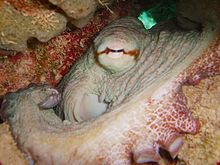
Octopuses have keen eyesight. Like other cephalopods, they can distinguish the polarization of light. Colour vision appears to vary from species to species, being present in O. aegina but absent in O. vulgaris.[45]
Attached to the brain are two special organs called statocysts (sac-like structures containing a mineralised mass and sensitive hairs), that allow the octopus to sense the orientation of its body. They provide information on the position of the body relative to gravity and can detect angular acceleration. An autonomic response keeps the octopus's eyes oriented so that the pupil is always horizontal.[22] Octopuses might also use the statocyst to register sound. The common octopus can hear sounds between 400 Hz and 1000 Hz, and hears best at a frequency of 600 Hz.[46]
Octopuses also have an excellent sense of touch. The octopus's suction cups are equipped with chemoreceptors so the octopus can taste what it is touching. The arms contain tension sensors so the octopus knows whether its arms are stretched out. However, it has a very poor proprioceptive sense. The tension receptors are not sufficient for the brain to determine the position of the octopus's body or arms. (It is not clear whether the octopus brain would be capable of processing the large amount of information that this would require; the flexibility of the octopus's arms is much greater than that of the limbs of vertebrates, which devote large areas of cerebral cortex to the processing of proprioceptive inputs.) As a result, the octopus does not possess stereognosis; that is, it does not form a mental image of the overall shape of the object it is handling. It can detect local texture variations, but cannot integrate the information into a larger picture.[47][48]
The neurological autonomy of the arms means the octopus has great difficulty learning about the detailed effects of its motions. The brain may issue a high-level command to the arms, but the nerve cords in the arms execute the details. There is no neurological path for the brain to receive proprioceptive feedback about just how its command was executed by the arms; the only way it knows just what motions were made is by observing the arms visually, i.e. exteroception.[48]
Lifecycle
Reproduction

Octopuses are gonochoric and have a single, posteriorly-located gonad which is associated with the coelom. The testis in males and the ovary in females bulges into the gonocoel and the gametes are released here. The gonocoel is connected by the gonoduct to the mantle cavity, which it enters at the gonopore. In most species, fertilisation occurs in the mantle cavity.[22] An optic gland creates hormones that allow the octopus to mature and age as well as stimulating gamete production. The gland may be triggered by environmental conditions such as temperature, light and nutrition, which thus control the timing of reproduction and lifespan.[49][50]
When octopuses reproduce, the male uses a specialised arm called a hectocotylus to transfer spermatophores (packets of sperm) from the terminal organ of the reproductive tract (the cephalopod "penis") into the female's mantle cavity.[51] The hectocotylus in benthic octopuses is usually the third right arm, there being a spoon-shaped depression and modified suckers near the tip.[22]
The reproduction of octopuses has been studied in only a few species. One such is the giant Pacific octopus; in this species, courtship is accompanied, especially in the male, by changes in skin texture and colour. The male may cling to the top or side of the female or position himself beside her. There is some speculation that he may first use his hectocotylus to remove any spermatophore or sperm already present in the female. He picks up a spermatophore from his spermatophoric sac with the hectocotylus and inserts it into the female's mantle cavity, depositing it in the correct location for the species, which in the case of the giant Pacific octopus, is the opening of the oviduct. Two spermatophores are transferred in this way, and as these are about one metre (yard) long, the empty ends may protrude from the female's mantle.[52] A complex hydraulic mechanism releases the sperm from the spermatophore, and it is stored internally by the female.[22]
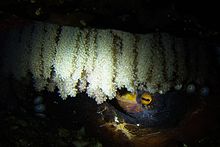
About forty days after mating, the female attaches strings of fertilised eggs (10,000 to 70,000 in total) to rocks in a crevice or under an overhang. Here she guards and cares for them for the 160 or so days until they hatch.[52] The female aerates the eggs and keeps them clean, and if left untended, many eggs will not hatch.[53] She does not feed during this time and dies soon afterwards. Males become senescent and die a few weeks after mating. If the optic gland is destroyed while the female is brooding, she resumes feeding and senescence is deferred.[54]
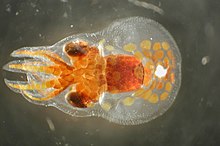
The eggs have large yolks; cleavage is superficial and a germinal disc develops at the pole. During gastrulation, the margins of this grow down and surround the yolk, forming a yolk sac, which eventually forms part of the gut. The dorsal side of the disc grows upwards and forms the embryo, with a shell gland on its dorsal surface, gills, mantle and eyes. The arms and funnel develop as part of the foot on the ventral side of the disc. The arms later migrate upwards, coming to form a ring around the funnel and mouth. The yolk is gradually absorbed as the embryo develops.[22]
After hatching, development is direct, with no trochophore or veliger larval stage.[22] The young paralarvae are planktonic for a while, feeding on copepods, arthropod larvae and other zooplankton. They then sink to the seabed to continue their development; some deep sea species do not have a planktonic stage.[55]
A rather different means of reproduction is adopted by the argonaut. The female secretes a fine, fluted, papery shell in which the eggs are deposited and in which she also resides while floating in mid-ocean. In this she broods the young, and it also serves as a buoyancy aid allowing her to adjust her depth. The male argonaut is minute by comparison and has no shell.[56]
Lifespan and mortality
Octopuses have a relatively short life expectancy, with some species living for as little as six months. Larger species, such as the giant Pacific octopus, may live for up to five years under suitable circumstances. However, reproduction is a cause of death: males can live for only a few months after mating, and females die shortly after their eggs hatch. They neglect to eat during the (roughly) one-month period spent taking care of their unhatched eggs, eventually dying of starvation. In a scientific experiment, the removal of both optic glands after spawning was found to result in the cessation of broodiness, the resumption of feeding, increased growth, and greatly extended lifespans.[57]
Behaviour and ecology

Octopus live in every ocean, and different species have adapted to different marine habitats. As juveniles, common octopuses inhabit shallow tide pools. The Hawaiian day octopus (Octopus cyanea) lives on coral reefs, while argonauts drift in pelagic waters. Abdopus aculeatus mostly lives in near-shore seagrass beds. Some species are adapted to the cold, ocean depths. The spoon-armed octopus (Bathypolypus arcticus) is found in abyssal plains at depths of 1,000 m (3,300 ft), while Vulcanoctopus hydrothermalis lives near hydrothermal vents at 2,000 m (6,600 ft).[23] No species are known to live in freshwater.[58]
Most species are solitary when not mating, although Pacific striped octopuses may share food and habitation.[59] Lacking a protective shell, they hide in dens; these are typically crevices in rocky outcrops or other hard structures, though some species burrow into sand or mud. Octopuses are not territorial and may leave an area in search of food. They are not known to be migratory.[60]
The den is a place of safety, and captured prey is brought back there for consumption. Sometimes the octopus catches more prey than it can eat, and the den is often surrounded by a midden of dead and uneaten food items. Other creatures often share the den with the octopus, either because they have arrived as scavengers, or because they have survived capture. They include fish, crabs, molluscs and echinoderms.[61]
Feeding

Nearly all octopuses are predatory; bottom-dwelling octopuses eat mainly crustaceans, polychaete worms, and other molluscs such as whelks and clams while open-ocean octopuses eat mainly prawns, fish and other cephalopods.[62] Major items in the diet of the giant Pacific octopus include bivalve molluscs such as the cockle Clinocardium nuttallii, clams and scallops, and crustaceans such as crabs and spider crabs. Prey likely to be rejected include moon snails, because they are too large, and limpets, rock scallops, chitons and abalone, because they are too securely fixed to the rock. There seems to be an element of selectivity involved in food choice; the relative importance of each prey species in the diet is related to its abundance in the environment; rare favoured items sometimes being neglected in favour of less-attractive but plentiful prey species.[61]
Bottom-dwelling octopuses move along the rocks and feel through the crevices. The creature may simply make a jet-propelled pounce on sighted prey and pull it towards the mouth with arms, the suckers restraining it. Small prey may be completely trapped by the webbed structure. With crustaceans like crabs, octopuses usually inject it with a paralysing saliva before dismembering it into small pieces with their beaks.[62][63] Octopuses feed on shelled molluscs either by forcing the valves apart, or by drilling a hole in the shell to inject a nerve toxin.[64][63] It used to be thought that the hole was drilled by the radula, but it has now been shown that minute teeth at the tip of the salivary papilla are involved, and an enzyme in the toxic saliva is used to dissolve the calcium carbonate of the shell. It takes about three hours for O. vulgaris to create a 0.6 mm (0.024 in) hole. Once the shell is penetrated, the prey dies almost instantaneously, its muscles relax and the soft tissues are easy for the octopus to remove. Crabs may also be treated in this way, tough-shelled species being more likely to be drilled, while soft-shelled crabs are just torn apart.[65]
Locomotion
Octopuses mainly move about by relatively slow crawling, with some swimming in a head-first position. Jet propulsion, or backwards swimming, is their fastest means of locomotion, followed by swimming and crawling.[66] When in no great hurry, they usually crawl on either solid or soft surfaces. Several arms are extended forwards, some of the suckers adhere to the substrate and the animal hauls itself forward with its powerful arm muscles, while other arms may push rather than pull. As progress is made, other arms move ahead to repeat these actions and the original suckers detach. During crawling, the heart rate nearly doubles, and the animal requires ten or fifteen minutes to recover from relatively minor exercise.[27]
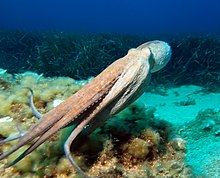
Octopuses swim by expelling a jet of water from the mantle through the siphon into the sea. The physical principle behind this is that the force required to accelerate the water through the orifice produces a reaction that propels the octopus in the opposite direction.[67] The direction of travel depends on the orientation of the siphon. When swimming, the head is at the front and the siphon is pointed backwards towards the posterior of the mantle, but when jetting, the visceral hump leads, the siphon points towards the head and the arms trail behind, with the animal presenting a fusiform appearance. In an alternative method of swimming, some species flatten themselves dorso-ventrally, and swim with the arms held out sideways, and this may provide some lift and be a faster method of progression than normal swimming. Although jetting is speedy and used to escape from danger, it is physiologically inefficient, requiring a mantle pressure so high as to stop the heart from beating, resulting in a progressive oxygen deficit.[66]
In 2005, Adopus aculeatus and veined octopus (Amphioctopus marginatus) were found to walk on two arms, while at the same time mimicking plant matter.[68] This form of locomotion allows these octopuses to move quickly away from a potential predator while possibly not triggering that predator's search image for octopus (food).[66] A study of this behaviour conducted by the Weymouth Sea Life Centre led to the suggestion that the two rearmost appendages may be more accurately termed "legs" rather than "arms".[69] Some species of octopus can crawl out of the water for a short period, which they may do between tide pools while hunting crustaceans or gastropods or to escape predators.[70][71] Another rare form of locomotion has been called "stilt walking". This is used by the veined octopus while carrying stacked coconut shells. Incommoded by this burden, carried underneath it by two arms, the octopus progresses with an ungainly gait supported by its remaining arms held rigid. The shells are later used to create a refuge.[72]
Intelligence

Octopuses are highly intelligent, possibly more so than any other order of invertebrates. The exact extent of their intelligence and learning capability is much debated among biologists,[73][74][75][76] but maze and problem-solving experiments have shown evidence of a memory system that can store both short- and long-term memory. It is not known precisely what contribution learning makes to adult octopus behaviour. Young octopuses learn almost no behaviours from their parents, with whom they have very little contact.[77] Some octopuses, such as the mimic octopus, will move their arms in ways that emulate the shape and movements of other sea creatures.[78]
In laboratory experiments, octopuses can be readily trained to distinguish between different shapes and patterns. They have been reported to practice observational learning,[79] although the validity of these findings is widely contested on a number of grounds.[73][74] Octopuses have also been observed in what some have described as play: repeatedly releasing bottles or toys into a circular current in their aquariums and then catching them.[80] Octopuses often break out of their aquariums and sometimes into others in search of food.[70][81][82] They have even boarded fishing boats and opened holds to eat crabs.[75]
The octopus has been shown to use tools. At least four specimens of the veined octopus have been witnessed retrieving discarded coconut shells, manipulating them, and then reassembling them to use as shelters.[83][84][72]
Defence
The octopus's primary defence is to hide or to disguise itself through camouflage and mimicry, though some have conspicuous warning coloration (aposematism).[85] An octopus may spend 40% of its time hidden away in its den. When this is approached, it may extend an arm to investigate. 66% of Enteroctopus dolfleini in one study had some degree of scarring, with 50% having amputated arms.[86]
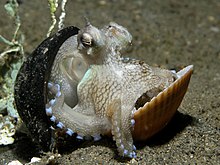
Octopuses have several secondary defences that they use once they have been seen by a predator: the most common is fast escape, but they also make use of distraction with ink sacs and autotomising limbs. Most octopuses can eject a thick, blackish ink in a large cloud to aid in escaping from predators. The main colouring agent of the ink is melanin, the same chemical that gives humans their hair and skin color. This ink cloud is thought to reduce the efficiency of olfactory organs, which would aid evasion from predators that employ smell for hunting, such as sharks. Ink clouds of some species might serve as pseudomorphs, or decoys that the predator attacks instead.[87]

The octopus's camouflage is aided by certain specialised skin cells which can change the apparent color, opacity, and reflectivity of the epidermis. Chromatophores contain yellow, orange, red, brown, or black pigments; most species have three of these colours, while some have two or four. Other colour-changing cells are reflective iridophores, and leucophores (white).[88] This colour-changing ability can also be used to communicate with or warn other octopuses. The highly venomous blue-ringed octopus becomes bright yellow with blue rings when it is provoked. Octopuses can use muscles in the skin to change the texture of their mantle to achieve a greater camouflage. In some species, the mantle can take on the spiky appearance of seaweed, or the scraggly, bumpy texture of a rock, among other disguises. However, in some species, skin anatomy is limited to relatively patternless shades of one colour, and limited skin texture. It is thought that octopuses that are day-active and/or live in complex habitats such as coral reefs have evolved more complex skin than their nocturnal and/or sand-dwelling relatives.[85]
When under attack, some octopuses can perform arm autotomy, in a manner similar to the way skinks and other lizards detach their tails. The crawling arm serves as a distraction to would-be predators. Such severed arms remain sensitive to stimuli and move away from unpleasant sensations.[89]
A few species, such as the mimic octopus, have a fourth defence mechanism. They can combine their highly flexible bodies with their colour-changing ability to accurately mimic other, more dangerous animals, such as lionfish, sea snakes, and eels.[90][91]
Evolution
Fossil history and phylogeny
Cephalopods have existed for around 500 million years and octopus ancestors were in the Carboniferous seas around 300 million years ago. The oldest octopus fossil is Pohlsepia dated to have lived around 296 million years ago. Researchers have identified impressions of eight arms, two eyes, and possibly an ink sac.[92] Being mostly soft tissue, fossils of octopuses are relatively rare. Octopuses, squids and cuttlefish belong to the clade Coleoidea. They are known as "soft-bodied" cephalopods, lacking the external shell of most molluscs and other cephalopods like the Nautiloids and the extinct Ammonoidea. However, some ancient coleoids, like the Belemnitida had internal shells.[93]
Extant genetic cephalopod phylogeny, based on Strugnell et al. 2007, is shown in the cladogram.[94]
| Cephalopods | |
Taxonomy
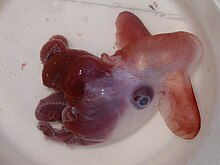
The scientific name Octopoda was first coined and given as the order of octopuses in 1818 by English biologist William Elford Leach.[95] The Octopoda consists of 300 known species[96] and can be divided into two suborders, the Incirrina and the Cirrina. The incirrate octopuses are distinguished from the cirrate octopuses by their absence of "cirri" or filaments (found with the suckers) and the lack of paired swimming fins on the head. The Cirrina have two fins and an internal shell, whereas the Incirrina (the majority of octopuses) have almost entirely soft bodies with no internal skeleton. They lack a protective outer shell like the nautilus; the cuttlefish and squid retain an internal bony structure that is the remnant of an external shell, while the rest of the cephalopods retain only a small sliver of hard chitin at the rear of the mantle. The cirrate species are often free-swimming and live in deep-water habitats, while incirrate octopuses are found in reefs and other shallower seafloor habitats.[97]
- Order Octopoda

Life restoration of Keuppia levante, an extinct species from the Cretaceous - Genus †Keuppia (incertae sedis)
- Genus †Palaeoctopus (incertae sedis)
- Genus †Paleocirroteuthis (incertae sedis)
- Genus †Pohlsepia (incertae sedis)
- Genus †Proteroctopus (incertae sedis)
- Genus †Styletoctopus (incertae sedis)
- Suborder Cirrina: finned deep-sea octopus
- Family Opisthoteuthidae: umbrella octopus
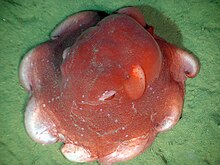
The flapjack octopus (Opisthoteuthis californiana) - Family Cirroctopodidae
- Family Cirroteuthidae
- Family Stauroteuthidae
- Suborder Incirrina
- Superfamily Octopodoidea
- Family Amphitretidae: telescope octopus
- Family Bolitaenidae: gelatinous octopus
- Family Octopodidae: benthic octopus
- Genus Enteroctopus: giant octopus
- Genus Octopus: the largest genus of octopuses
- Family Vitreledonellidae: glass octopus
- Superfamily Argonautoidea

Shelled argonaut, Argonauta argo - Family Alloposidae: seven-arm octopus
- Family Argonautidae: argonauts
- Family Ocythoidae: tuberculate pelagic octopus
- Family Tremoctopodidae: blanket octopus
- Superfamily Octopodoidea
RNA editing
Octopuses and other coleoid cephalopods are capable of greater RNA editing (which involves changes to the nucleic acid sequence of the primary transcript of RNA molecules) than any other organisms. Such editing is particularly concentrated in the nervous system and has affected proteins involved in neural excitability and neuronal morphology. More than 60% of RNA transcripts for coleoid brains are recoded by editing, compared to less than 1% for a human or fruit fly. Coleoids rely mostly on ADAR enzymes for RNA editing, which requires large double-stranded RNA structures to flank to the editing sites. Both the structures and editing sites are conserved in the coleoid genome and the mutation rates for the sites are severely hampered. Hence, greater transcriptome plasticity has come as the cost of slower genome evolution. High levels of RNA editing do not appear to be present in more basal cephalopods or other molluscs.[98][99]
Relationship to humans

In ancient times
Ancient peoples of the Mediterranean were aware of the octopus, as evidenced by certain artworks and designs of prehistory. For example, a stone carving found in the archaeological recovery from Bronze Age Minoan Crete at Knossos (1900 – 1100 BC) has a depiction of a fisherman carrying an octopus.[100]
In classical Greece, Aristotle (384 BC – 322 BC) commented on the colour-changing abilities of the octopus, both for camouflage and for signalling, in his Historia animalium:[101]
The octopus ... seeks its prey by so changing its colour as to render it like the colour of the stones adjacent to it; it does so also when alarmed.
— Aristotle[101]
Aristotle noted that the octopus had a hectocotyl arm and suggested it might be used in sexual reproduction. This claim was widely disbelieved until its rediscovery in the 19th century. It was described in 1829 by the French zoologist Georges Cuvier, who supposed it to be a parasitic worm, naming it as a new species, Hectocotylus octopodis.[102][103] Other zoologists thought it a spermatophore; the German zoologist Heinrich Müller believed it was designed to detach during copulation. Finally in 1856 the Danish zoologist Japetus Steenstrup demonstrated that while it is used to transfer sperm, it only rarely detaches.[104]
Octopuses were often depicted in the art of the Moche people of ancient Peru, who worshipped the sea and its animals.[105]
In mythology
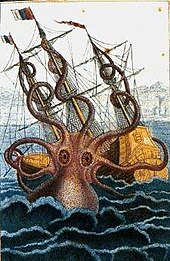
The Gorgon of Greek mythology has been thought to have been inspired by the octopus or squid, the octopus itself representing the severed head of Medusa, the beak as the protruding tongue and fangs, and its tentacles as the snakes.[106] The Kraken are legendary sea monsters of giant proportions said to dwell off the coasts of Norway and Greenland, usually portrayed in art as a giant octopus attacking ships. Linnaeus included it in the first edition of his 1735 Systema Naturae.[107][108] The Hawaiian creation myth relates that the present cosmos is only the last of a series, having arisen in stages from the wreck of the previous universe. In this account, the octopus is the lone survivor of the previous, alien universe.[109] The Akkorokamui is a gigantic octopus-like monster from Ainu folklore.[110]
Danger
While octopuses generally avoid humans, attacks have occasionally been verified. For example, an 8 feet (2.4 m) Pacific octopus, said to be nearly perfectly camouflaged, "lunged" at a diver and "wrangled" over his camera, wrapping its arms around the diver's before letting go. Another diver recorded the encounter on video.[111]
The supposed attack on a Staten Island ferry in New York, leading to the loss of the ferry and commemorated by a bronze sculpture, never actually occurred, nor was there any such ferry disaster.[112]
While all species are venomous, only blue-ringed octopuses have venom that is lethal to humans.[113] They generally are unaggressive, but bites are reported each year across the animals' range from Australia to the eastern Indo-Pacific Ocean. They bite only when provoked or accidentally stepped upon. Bites are small and usually painless. The venom appears to be able to penetrate the skin without a puncture, given prolonged contact. The venom contains tetrodotoxin, which causes paralysis by blocking the transmission of nerve impulses to the muscles. This causes death by respiratory failure leading to cerebral anoxia. No antidote is known, but if breathing can be kept going artificially, then patients recover within 24 hours.[114][115] Bites have been recorded from captive octopuses of other species; they leave swellings which disappear in a day or two.[116]
In literature
A battle with an octopus plays a significant role in Victor Hugo's book Travailleurs de la mer (Toilers of the Sea), relating to his time in exile on the island of Guernsey.[117] Ian Fleming's 1966 short story collection Octopussy and The Living Daylights, and the 1983 James Bond film were partly inspired by Hugo's book.[118]
In John Steinbeck's novella Sweet Thursday, the marine biologist "Doc" is studying what the denizens of Cannery Row call "devilfish". Doc's study of octopuses to ascertain whether their behaviour displays emotional responses similar to humans, such as apoplexy, is a major plot device in the novella.[119] The former Beatle Ringo Starr wrote a 2014 children's book based on his 1969 song "Octopus's Garden". The book is illustrated by Ben Court.[120]
In art and media

The biologist P. Z. Myers noted in his science-blog, Pharyngula, that octopuses appear in "extraordinary" graphic illustrations involving women, tentacles, and bare breasts.[121][122] In Japan, erotic art, shunga, includes ukiyo-e woodblock prints such as Katsushika Hokusai's 1814 print Tako to ama (The Dream of the Fisherman's Wife), in which an ama diver is sexually intertwined with a large and a small octopus.[123][124] The print is a forerunner of tentacle erotica.[125]
As food

Octopus is eaten in many cultures. They are a common food in Mediterranean and Asian sea areas.[126][127] The arms and sometimes other body parts are prepared in various ways, often varying by species or geography. Live octopuses are eaten in several countries around the world, including the US.[128][129] Animal welfare groups have objected to this practice on the basis that octopuses can experience pain.[130] Octopuses have a food conversion efficiency greater than that of chickens, making them a possible candidate for farming.[131]
In captivity
Though octopuses can be difficult to keep in captivity, some people keep them as pets. Their den-dwelling and nocturnal behaviours, short lifespans and sensitivities to changes in water chemistry contribute to the difficulty of maintaining them in captivity.[132] They are also able to escape from supposedly secure tanks due to their problem-solving skills, mobility and lack of rigid structure. Occasionally, octopuses escape from their tanks in public aquariums.[133]
As a metaphor

Since it has numerous arms emanating from a common center, the octopus is often used as a metaphor for a powerful and manipulative organization, sometimes negatively.[134]
In science and technology
Octopuses offer many possibilities in biological research, including their ability to regenerate limbs, change the colour of their skin, behave intelligently with a distributed nervous system, and make use of 168 kinds of protocadherins (where humans have 58), the proteins that guide the connections neurons make with each other. The California two-spot octopus has had its genome sequenced, allowing exploration of its molecular adaptations.[135] Having independently evolved mammal-like intelligence, octopuses have been compared to hypothetical intelligent extraterrestrials.[136]
Some robotics research is exploring biomimicry of octopus features. Octopus arms can move and sense largely autonomously without intervention from the animal's central nervous system. A team in Italy has built soft-bodied robots able to crawl and swim, using only limited amounts of computation.[137] A German company has made a grasping arm with a soft pneumatically controlled silicone gripper fitted with two rows of suckers, which Wired calls a "tentacle". It is able to grasp objects such as a metal tube, a magazine, or a ball, and to fill a glass by pouring water from a bottle.[138]
Legal protection
Due to their intelligence, octopuses are listed in some countries as experimental animals on which surgery may not be performed without anesthesia, a protection usually extended only to vertebrates. In the UK from 1993 to 2012, the common octopus (Octopus vulgaris) was the only invertebrate protected under the Animals (Scientific Procedures) Act 1986.[139] In 2012, this legislation was extended to include all cephalopods[140] in accordance with a general EU directive.[141]
See also
- Octopus wrestling
- Paul the Octopus, famous for predicting football results in the 2010 FIFA World Cup
References
- ^ "ITIS Report: Octopoda Leach, 1818". Itis.gov. 2013-04-10. Retrieved 2014-02-04.
- ^ "Coleoidea – Recent cephalopods". Mikko's Phylogeny Archive.
- ^ "Online Etymology Dictionary". Etymonline.com. Retrieved 2014-02-04.
- ^ "Octopus". Dictionary.reference.com. Retrieved 2014-02-04.
- ^ Liddell, Henry George; Scott, Robert. "ὀκτώπους". A Greek-English Lexicon. Perseus.tufts.edu. Retrieved 2014-02-04.
- ^ a b "Octopus". Oxforddictionaries.com. 2014. Retrieved 2014-02-04.
- ^ Michel, Jean-Baptiste; Shen, Yuan; Aiden, Aviva; Veres, Adrian; Gray, Matthew; Pickett, Joseph; Hoiberg, Dale; Clancy, Dan; Norvig, Peter; Orwant, Jon; Pinker, Steven; Nowak, Martin; The Google Books Team (2011). "Quantitative Analysis of Culture Using Millions of Digitized Books". Science. 331 (6014): 176–182. doi:10.1126/science.1199644. PMC 3279742. PMID 21163965. Relevant data at Google Ngram Viewer.
{{cite journal}}:|last13=has generic name (help); External link in|postscript= - ^ Peters, Pam (2004). The Cambridge Guide to English Usage. Cambridge: Cambridge University Press. ISBN 0-521-62181-X, p. 388.
- ^ Fowler's Modern English Usage states that the only acceptable plural in English is "octopuses", that "octopi" is misconceived, and "octopodes" pedantic.
- ^ Chambers 21st Century Dictionary (retrieved 2007-10-19 )
- ^ Stamper, Kory. Ask the editor: octopus. Merriam-Webster. Retrieved 2013-06-26.
- ^ "Octopus". OED.com. Retrieved 2010-02-01.
- ^ "octopus". Oxford English Dictionary (Online ed.). Oxford University Press. (Subscription or participating institution membership required.)
- ^ Stevenson, Angus; Lindberg, Christine A., eds. (2010). New Oxford American Dictionary (3rd ed.). Oxford University Press. ISBN 978-0-19-539288-3.
- ^ "Smithsonian National Zoological Park: Giant Pacific Octopus". Nationalzoo.si.edu. Retrieved 2014-02-04.
- ^ Cosgrove, J.A. 1987. Aspects of the Natural History of Octopus dofleini, the Giant Pacific Octopus. M.Sc. Thesis. Department of Biology, University of Victoria (Canada), 101 pp.
- ^ O'Shea, S. (2004). "The giant octopus Haliphron atlanticus (Mollusca : Octopoda) in New Zealand waters". New Zealand Journal of Zoology. 31 (1): 7–13. doi:10.1080/03014223.2004.9518353.
- ^ O'Shea, S. (2002). "Haliphron atlanticus – a giant gelatinous octopus" (PDF). Biodiversity Update. 5: 1.
- ^ Norman, M. 2000. Cephalopods: A World Guide. ConchBooks, Hackenheim. p. 214.
- ^ High, William L. (1976). "The giant Pacific octopus" (PDF). Marine Fisheries Review. 38 (9). U.S. National Marine Fisheries Service: 17–22.
- ^ Bradford, Alina (2016-07-21). "Octopus Facts". Live Science. Retrieved 2017-04-26.
- ^ a b c d e f g h i j k l m Ruppert, Edward E.; Fox, Richard S.; Barnes, Robert D. (2008). Invertebrate Zoology. Cengage Learning. pp. 363–364. ISBN 978-81-315-0104-7.
- ^ a b Mather, Anderson & Wood (2010), pp. 13–15.
- ^ a b c Courage (2013), pp. 40–41.
- ^ Semmens (2004). "Understanding octopus growth: patterns, variability and physiology". Marine and Freshwater Research. 55: 367. doi:10.1071/MF03155.
- ^ Wells (1978), pp. 11–12.
- ^ a b Crowfoot, Thomas. "Octopuses and Relatives: Locomotion, Crawling". A Snail's Odyssey. Retrieved 2017-04-19.
- ^ Zelman, I.; Titon, M.; Yekutieli, Y.; Hanassy, S.; Hochner, B.; Flash, T. (2013). "Kinematic decomposition and classification of octopus arm movements". Frontiers in Computational Neuroscience. doi:10.3389/fncom.2013.00060. PMC 3662989. PMID 23745113.
{{cite journal}}: CS1 maint: unflagged free DOI (link) - ^ Tramacere, F.; Beccai, L.; Kuba, M.; Gozzi, A.; Bifone, A.; Mazzolai, B. (2013). "The morphology and adhesion mechanism of Octopus vulgaris suckers". PLOS ONE. 8 (6): e65074. doi:10.1371/journal.pone.0065074. PMC 3672162. PMID 23750233.
{{cite journal}}: CS1 maint: unflagged free DOI (link) - ^ Kier, W. M.; Smith, A. M. (2002). "The structure and adhesive mechanism of octopus suckers". Integrative and Comparative Biology. 42 (6): 1146–1153. doi:10.1093/icb/42.6.1146. PMID 21680399.
- ^ a b Wells (1978), pp. 31–35.
- ^ a b Courage (2013), pp. 42–43.
- ^ a b Schmidt-Nielsen, Knut (1997). Animal Physiology: Adaptation and Environment. Cambridge University Press. p. 117. ISBN 0-521-57098-0.
- ^ Crowfoot, Thomas. "Octopuses and Relatives: Locomotion, jet propulsion". A Snail's Odyssey. Retrieved 2017-04-26.
- ^ Wells, M. J.; Wells, J. (1995). "The control of ventilatory and cardiac responses to changes in ambient oxygen tension and oxygen demand in Octopus". The Journal of Experimental Biology. 198: 1717–1727. PMID 9319626.
- ^ a b Wells, J. (1996). "Cutaneous respiration in Octopus vulgaris". The Journal of Experimental Biology. 199: 2477–2483. PMID 9320405.
- ^ Wells (1978), pp. 24–26.
- ^ Wells (1978), pp. 54–56.
- ^ Wells (1978), pp. 73–79.
- ^ Boyle, P. R. (2013). "Neural Control of Cephalopod Behavior". In Dennis Willows, A.O. (ed.). The Mollusca, Volume 8: Neurobiology and Behavior, Part 2. Academic Press. ISBN 0-12-751409-0.
- ^ Yekutieli, Y.; Sagiv-Zohar, R.; Aharonov, R.; Engel, Y.; Hochner, B.; Flash, T. (2005). "Dynamic model of the octopus arm. I. Biomechanics of the octopus reaching movement". J. Neurophysiol. 94 (2): 1443–58. doi:10.1152/jn.00684.2004. PMID 15829594.
- ^ Zullo, L.; Sumbre, G.; Agnisola, C.; Flash, T.; Hochner, B. (2009). "Nonsomatotopic organization of the higher motor centers in Octopus". Curr. Biol. 19 (19): 1632–6. doi:10.1016/j.cub.2009.07.067. PMID 19765993.
- ^ Greenfieldboyce, Nell (2014-05-15). "Why This Octopus Isn't Stuck-Up". NPR.org.
- ^ Mather, Anderson & Wood (2010), p. 107.
- ^ Kawamura, G.; et al. (2001). "Color Discrimination Conditioning in Two Octopus Octopus aegina and O. vulgaris" (PDF). Nippon Suisan Gakkashi. 67 (1): 35–39. doi:10.2331/suisan.67.35.
- ^ Walker, Matt (2009-06-15). "The cephalopods can hear you". BBC. Retrieved 2013-07-19.
- ^ Wells (1978), pp. 170–174.
- ^ a b Wells (1978), pp. 228–240.
- ^ Mather, Anderson & Wood (2010), p. 147.
- ^ Wells, Martin J.; Wells, J. (1972). "Optic glands and the state of the testis in Octopus". Marine Behaviour and Physiology. 1 (1–4): 71–83. doi:10.1080/10236247209386890.
- ^ Young, R. E.; Vecchione, M.; Mangold, K. M. (1999). "Cephalopoda Glossary". Tree of Life web project.
- ^ a b Crowfoot, Thomas. "Octopuses and Relatives: Reproduction". A Snail's Odyssey. Retrieved 2017-04-11.
- ^ Scheel, David. "Giant Octopus: Fact Sheet". Alaska Pacific University. Archived from the original on 2012-11-15. Retrieved 2017-04-09.
{{cite web}}: Unknown parameter|deadurl=ignored (|url-status=suggested) (help) - ^ Anderson, Roland C.; Mather, Jennifer A.; Wood, James B. (2013). Octopus: The Ocean's Intelligent Invertebrate. Timber Press. p. 147. ISBN 978-1-60469-500-7.
- ^ "Octopus Fact Sheet" (PDF). World Animal Foundation. Retrieved 2017-04-12.
- ^ Simon, Matt (2015-01-16). "Absurd Creature of the Week: The Beautiful Octopus Whose Sex Is All About Dismemberment". Wired: Science. Retrieved 2017-05-20.
- ^ Wodinsky, Jerome (1977). "Hormonal Inhibition of Feeding and Death in Octopus: Control by Optic Gland Secretion". Science. 198 (4320): 948–951. doi:10.1126/science.198.4320.948. PMID 17787564.
- ^ Norman, Mark (2013-01-16). "Ask an expert: Are there any freshwater cephalopods?". ABC Science. Retrieved 2017-04-26.
- ^ Edmonds, Patricia (April 2017). "What's Odd About That Octopus? It's Mating Beak to Beak". National Geographic.
- ^ Courage (2013), pp. 45–46.
- ^ a b Crowfoot, Thomas. "Octopuses and Relatives: Feeding, diets and growth". A Snail's Odyssey. Retrieved 2017-04-13.
- ^ a b Wassilieff, Maggy; O'Shea, Steve (2009-03-02). "Octopus and squid – Feeding and predation". Te Ara – the Encyclopedia of New Zealand.
- ^ a b Wells (1978), pp. 74–75.
- ^ Wodinsky, Jerome (1969). "Penetration of the Shell and Feeding on Gastropods by Octopus". American Zoologist. 9 (3): 997–1010. doi:10.1093/icb/9.3.997.
- ^ Crowfoot, Thomas. "Octopuses and Relatives: Prey handling and drilling". A Snail's Odyssey. Retrieved 2017-04-21.
- ^ a b c Huffard, Christine L. (2006). "Locomotion by Abdopus aculeatus (Cephalopoda: Octopodidae): walking the line between primary and secondary defenses". Journal of Experimental Biology. 209: 3697–3707. doi:10.1242/jeb.02435. PMID 16985187. Retrieved 2014-02-04.
- ^ Kassim, I.; Phee, L.; Ng, W. S.; Gong, F.; Dario, P.; Mosse, C. A. (2006). "Locomotion techniques for robotic colonoscopy". IEEE Engineering in Medicine and Biology Society. 25 (3): 40–56. doi:10.1109/MEMB.2006.1636351.
- ^ Huffard, C. L.; Boneka, F.; Full, R. J. (2005). "Underwater Bipedal Locomotion by Octopuses in Disguise". Science. 307 (5717): 1927. doi:10.1126/science.1109616. PMID 15790846.
- ^ Octopuses have only six arms, the other two are actually legs! Hindustan Times, 2008-08=13.
- ^ a b Wood, James B.; Anderson, Roland C. (2004). "Interspecific Evaluation of Octopus Escape Behavior" (PDF). Journal of Applied Animal Welfare Science. 7 (2). Lawrence Erlbaum Associates: 95–106. doi:10.1207/s15327604jaws0702_2. PMID 15234886. Retrieved 2015-09-11.
- ^ Harmon, Katherine (2011-11-24). "Land-Walking Octopus Explained". Octopus Chronicles. Scientific American. Retrieved 2011-11-24.
- ^ a b Finn, J. K.; Tregenza, T.; Norman, M. D. (2009). "Defensive tool use in a coconut-carrying octopus". Current Biology. 19 (23): R1069–70. doi:10.1016/j.cub.2009.10.052. PMID 20064403.
- ^ a b Hamilton, Garry. "What is this octopus thinking?". Archived from the original on 2012-04-07.
{{cite web}}: Unknown parameter|deadurl=ignored (|url-status=suggested) (help) - ^ a b Stewart, Doug (1997). "Armed but not dangerous: Is the octopus really the invertebrate intellect of the sea". National Wildlife. 35 (2). URL is not the source.
- ^ a b "Giant Octopus – Mighty but Secretive Denizen of the Deep". Web.archive.org. 2008-01-02. Archived from the original on 2012-08-25. Retrieved 2014-02-04.
{{cite web}}: Unknown parameter|deadurl=ignored (|url-status=suggested) (help) - ^ Zimmer, Carl (2008-06-23). "How Smart is the Octopus?". Slate.com.
- ^ "Giant Pacific Octopus (Enteroctopus dofleini) Care Manual" (PDF). AZA (Association of Zoos and Aquariums) Aquatic Invertebrate Taxonomic Advisory Group IN ASSOCIATION WITH AZA Animal Welfare Committee. 2014-09-09. Retrieved 2016-05-31.
- ^ Mather, Anderson & Wood (2010), pp. 109.
- ^ "Octopus intelligence: Jar opening". BBC News. 2003-02-25. Retrieved 2014-02-04.
- ^ Mather, J. A.; Anderson, R. C. (1998). Wood, J. B. (ed.). "What behavior can we expect of octopuses?". The Cephalopod Page.
- ^ Lee, Henry (1875). "V: The octopus out of water". Aquarium Notes – The Octopus; or, the "devil-fish" of fiction and of fact. London: Chapman and Hall. pp. 38–39. OCLC 1544491. Retrieved 2015-09-11.
The marauding rascal had occasionally issued from the water in his tank, and clambered up the rocks, and over the wall into the next one; there he had helped himself to a young lump-fish, and, having devoured it, returned demurely to his own quarters by the same route, with well-filled stomach and contented mind.
- ^ Roy, Eleanor Ainge (2016-04-14). "The great escape: Inky the octopus legs it to freedom from aquarium". The Guardian (Australia).
- ^ Morelle, Rebecca (2009-12-14). "Octopus snatches coconut and runs". BBC News. Retrieved 2010-05-20.
- ^ "Coconut shelter: evidence of tool use by octopuses". EduTube Educational Videos. Retrieved 2014-02-04.
- ^ a b Hanlon, R. T.; Messenger, J. B. (1996). Cephalopod Behaviour. Cambridge University Press. pp. 66–87. ISBN 0-521-64583-2.
- ^ Crowfoot, Thomas. "Octopuses and Relatives: Predators and Defenses". A Snail's Odyssey. Retrieved 2017-04-13.
- ^ Caldwell, R. L. (2005). "An Observation of Inking Behavior Protecting Adult Octopus bocki from Predation by Green Turtle (Chelonia mydas) Hatchlings". Pacific Science. 59 (1): 69–72. doi:10.1353/psc.2005.0004.
- ^ Meyers, Nadia. "Tales from the Cryptic: The Common Atlantic Octopus". Southeastern Regional Taxonomic Centre. Retrieved 2006-07-27.
- ^ Harmon, Katherine (2013-08-27). "Even Severed Octopus Arms Have Smart Moves". Octopus Chronicles. Scientific American.
- ^ Norman, M. D.; Finn, J.; Tregenza, T. (2001). "Dynamic mimicry in an Indo-Malayan octopus" (PDF). Proceedings of the Royal Society. 268 (1478): 1755–8. doi:10.1098/rspb.2001.1708. PMC 1088805. PMID 11522192.
- ^ Norman, M. D. (2005). "The 'Mimic Octopus' (Thaumoctopus mimicus n. gen. et sp.), a new octopus from the tropical Indo-West Pacific (Cephalopoda: Octopodidae)". Molluscan Research. 25 (2): 57–70.
- ^ Courage (2013), p. 4.
- ^ "A Broad Brush History of the Cephalopoda". The Cephalopod Group. Retrieved 2017-03-27.
- ^ Strugnell, J.; Nishiguchi, M. K. (2007). "Molecular phylogeny of coleoid cephalopods (Mollusca: Cephalopoda) inferred from three mitochondrial and six nuclear loci: a comparison of alignment, implied alignment and analysis methods". Journal of Molluscan Studies. 73 (4): 399–410. doi:10.1093/mollus/eym038.
- ^ Gofas, S. (2009). "Octopoda ". WoRMS. World Register of Marine Species. Retrieved 5 May 2017.
- ^ Mather, Anderson & Wood (2010), p. 145.
- ^ Marshall Cavendish Corporation (2004). Encyclopedia of the Aquatic World. Marshall Cavendish. p. 764. ISBN 978-0-7614-7424-1.
- ^ Courage (2013), pp. 46–49.
- ^ Liscovitch-Brauer, N.; Alon, S.; Porath, H. T.; Elstein, B.; Unger, R.; Ziv, T.; Admon, A.; Levanon, E. Y.; Rosenthal, J. J. C.; Eisenberg, E. (2017). "Trade-off between transcriptome plasticity and genome evolution in cephalopods". Cell. 169 (2): 191–202. doi:10.1016/j.cell.2017.03.025.
- ^ Hogan, C. Michael (2007-12-22). "Knossos fieldnotes". The Modern Antiquarian.
- ^ a b Aristotle (c. 350 BC). Historia animalium. IX, 622a: 2–10. Cited in Borrelli, Luciana; Gherardi, Francesca; Fiorito, Graziano (2006). A catalogue of body patterning in Cephalopoda. Firenze University Press. ISBN 978-88-8453-377-7. Abstract
- ^ Leroi, Armand Marie (2014). The Lagoon: How Aristotle Invented Science. Bloomsbury. pp. 71–72. ISBN 978-1-4088-3622-4.
{{cite book}}: Unknown parameter|titlelink=ignored (|title-link=suggested) (help) - ^ "The Cephalopoda". University of California Museum of Paleontology. Retrieved 2017-03-27.
- ^ Mann, T. (2012). Spermatophores: Development, Structure, Biochemical Attributes and Role in the Transfer of Spermatozoa. Springer. p. 28. ISBN 978-3-642-82308-4.
- ^ Berrin, Katherine; Larco Museum. (1997). The Spirit of Ancient Peru: Treasures from the Museo Arqueológico Rafael Larco Herrera. New York: Thames and Hudson. ISBN 978-0-500-01802-6.
- ^ Wilk, Stephen R. (2000). Medusa: Solving the Mystery of the Gorgon. Oxford University Press. ISBN 0-19-988773-X.
- ^ "Caroli Linnaei Systema naturae sistens regna tria naturae". google.com.
- ^ Smedley, Edward; Rose, Hugh James; Rose, Henry John (1845). Encyclopaedia Metropolitana, Or, Universal Dictionary of Knowledge: Comprising the Twofold Advantage of a Philosophical and an Alphabetical Arrangement, with Appropriate Engravings. B. Fellowes. pp. 255–.
- ^ Dixon, Roland Burrage (1916). Oceanic. The Mythology of All Races. Vol. 9. Marshall Jones Company. pp. 2–.
- ^ Swancer, Brent via Coleman, Loren. Akkorokamui. Cryptomundo. http://www.cryptomundo.com/cryptozoo-news/akkorokamui
- ^ Ross, Philip (2014-02-18). "8-Foot Octopus Wrestles Diver Off California Coast, Rare Encounter Caught On Camera". International Business Times.
- ^ "New York monument honours victims of giant octopus attack that never occurred". The Guardian. 2016-10-01.
- ^ "Tentacles of venom: new study reveals all octopuses are venomous". University of Melbourne. 2009-04-15.
- ^ "Blue-ringed Octopuses, Hapalochlaena maculosa". The MarineBio Conservation Society. Retrieved 2017-04-12.
- ^ Caldwell, Roy. "What makes blue-rings so deadly? Blue-ringed octopus' have tetrodotoxin". The Cephalopod Page. Retrieved 2017-04-12.
- ^ Wells (1978), pp. 68.
- ^ Chisholm, Hugh, ed. (1911). . Encyclopædia Britannica (11th ed.). Cambridge University Press.
- ^ Cohen-Vrignaud, Gerard (2012). "Duke University Press On Octopussies, or the Anatomy of Female Power". differences. 23 (2): 32–61. doi:10.1215/10407391-1533520.
- ^ "Sweet Thursday – Plot Synopsis". Steinbeck in the Schools. San José State University. Retrieved 2015-01-05.
- ^ Starr, Ringo; Cort, Bud. "Octopus's Garden". Simon & Schuster. Retrieved 2015-01-05.
- ^ Myers, P. Z. (2017-05-17). "Extraordinary Octopus Illustrations". Pharyngula. Retrieved 2017-03-18.
- ^ Myers, P. Z. (2006-10-29). "Definitely not safe for work". Pharyngula. Retrieved 2017-03-18.
- ^ Fritze, Sointu; Suojoki, Saara (2000). Forbidden Images: Erotic Art from Japan's Edo Period (in Finnish). Helsingin kaupungin taidemuseo. pp. 23–28. ISBN 978-951-8965-54-4.
- ^ Uhlenbeck, Chris; Margarita Winkel; Ellis Tinios; Amy Reigle Newland (2005). Japanese Erotic Fantasies: Sexual Imagery of the Edo Period. Hotei. p. 161. ISBN 90-74822-66-5.
- ^ Briel, Holger (2010). Berninger, Mark; Ecke, Jochen; Haberkorn, Gideon (eds.). The Roving Eye Meets Traveling Pictures: The Field of Vision and the Global Rise of Adult Manga. McFarland. p. 203. ISBN 978-0-7864-3987-4.
{{cite book}}:|work=ignored (help) - ^ "Common octopus". Animal fact guide.
- ^ "Giant Pacific octopus". Monterey Bay Aquarium.
- ^ Eriksen, L. (2010-11-10). "Live and let dine". The Guardian. Retrieved 2015-04-15.
- ^ Killingsworth, Silvia (2014-10-03). "Why not eat octopus?". The New Yorker. Retrieved 2016-04-15.
- ^ Ferrier, M. (2010-05-30). "Macho foodies in New York develop a taste for notoriety". The Guardian. Retrieved 2015-04-15.
- ^ New Scientist. Reed Business Information. 1983. pp. 333–334. ISSN 0262–4079.
{{cite book}}: Check|issn=value (help) - ^ Courage, Katherine Harmon (2013-11-13). "Why Tracy Morgan's Pet Octopus Should Be a Dog". Scientific American. Retrieved 2017-04-15.
- ^ Brulliard, Karin (2016-04-13). "Octopus slips out of aquarium tank, crawls across floor, escapes down pipe to ocean". The Washington Post. Retrieved 2017-02-20.
- ^ Palmer, Jessica (2010-05-30). "Nazi Tentacles: The octopus as visual metaphor". Scienceblogs.com. Retrieved 2014-02-04.
- ^ Singer, Emily (2016-07-26). "Biologists Search for New Model Organisms". Quanta Magazine.
- ^ Baer, Drake (2016-12-20). "Octopuses Are 'the Closest We Will Come to Meeting an Intelligent Alien'". Science of Us. Retrieved 2017-04-26.
- ^ "Octopus-Inspired Robots Can Grasp, Crawl, and Swim". IEEE Spectrum. 2015-04-05.
- ^ Burgess, Matt (2017-03-27). "This robotic octopus tentacle isn't creepy at all". Wired.
- ^ "The Animals (Scientific Procedures) Act (Amendment) Order 1993". The National Archives. Retrieved 2015-02-18.
- ^ "The Animals (Scientific Procedures) Act 1986 Amendment Regulations 2012". The National Archives. Retrieved 2015-02-18.
- ^ "Directive 2010/63/EU of the European Parliament and of the Council". Article 1, 3(b) (see page 276/39): Official Journal of the European Union. Retrieved 2015-02-18.
{{cite web}}: CS1 maint: location (link)
Sources
- Wells, M. J. (1978). Octopus, Physiology and Behaviour of an Advanced Invertebrate. Springer Science & Business Media. ISBN 978-94-017-2470-8.
{{cite book}}: Invalid|ref=harv(help) - Courage, K. H. (2013). Octopus!, The Most Mysterious Creature in the Sea. Penguin Group. ISBN 978-0-698-13767-7.
{{cite book}}: Invalid|ref=harv(help) - Mather, J. A.; Anderson, R. C.; Wood, J. B. (2010). Octopus: The Ocean's Intelligent Invertebrate. Timber Press. ISBN 978-1-60469-067-5.
{{cite book}}: Invalid|ref=harv(help)
External links
- The Cephalopod Page
- Tree of Life website: information about cephalopods along with pictures and videos
- An octopus's shark encounter – footage of an octopus eating a shark (also in QuickTime format)
- Camouflage in action
- Video showing an Octopus escaping through a 1-inch (25 mm) hole
- Bipedal Octopuses- Video, Information, Original paper
- "Why Cephalopods Change Color" (PDF). (359 KB)
- Video of walking octopuses









